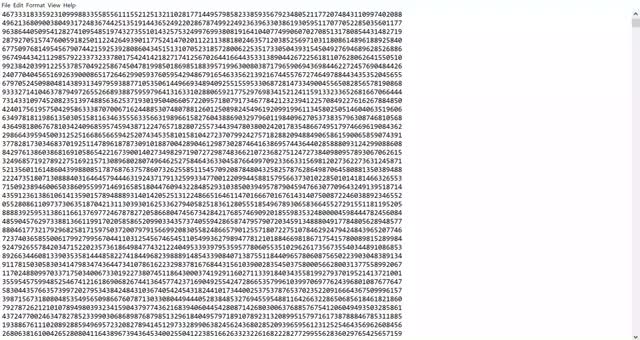There’s a new biggest known prime number in the universe.
Despite being a ridiculously huge number (just that text file, which readers can download here, takes up more than 23 megabytes of space on a computer), M77232917 can’t be divided up without using fractions. It won’t break into integers no matter what other factors, large or small, someone divides it by. Its only factors are itself and the number 1. That’s what makes it prime.
So how big is this number? A full 23,249,425 digits long — nearly 1 million digits longer than the previous record holder. If someone started writing it down, 1,000 digits a day, today (Jan. 8), they would finish on Sept. 19, 2081, according to some back-of-the-napkin calculations at Live Science.
Fortunately, there’s a simpler way to write the number: 2^77,232,917 minus 1. In other words, the new largest known prime number is one less than 2 times 2 time 2 times 2…and so on 77,232,917 times. [The 9 Most Massive Numbers in the Universe]
This isn’t really a surprise. Primes that are one less than a power of 2 belong to a special class, called Mersenne primes. The smallest Mersenne prime is 3, because it’s prime and also one less than 2 times 2. Seven is also a Mersenne prime: 2 times 2 times 2 minus 1. The next Mersenne prime is 31 — or 2^5-1.
This Mersenne prime, 2^77,232,917-1, turned up in the Great Internet Mersenne Primes Search (GIMPS) — a massive collaborative project involving computers all over the world — in late December 2017. Jonathan Pace, a 51-year-old electrical engineer living in Germantown, Tennessee, who had participated in GIMPS for 14 years, gets credit for the discovery, which turned up on his computer. Four other GIMPS hunters using four different programs verified the prime over the course of six days, according to the Jan. 3 GIMPS announcement.
Mersenne primes get their names from the French monk Marin Mersenne, as the University of Tennessee mathematician Chris Caldwell explained on his website. Mersenne, who lived from 1588 to 1648, proposed that 2^n-1 was prime when n equals 2, 3, 5, 7, 13, 17, 19, 31, 67, 127 and 257, and not prime for all other numbers less than 257 (2^257-1).
This was a pretty good stab at an answer from a monk working three and a half centuries before the dawn of modern prime-solving software — and a big improvement over writers before 1536, who believed that 2 multiplied by itself any prime number of times minus 1 would be prime. But it wasn’t quite right.
Mersenne’s largest number, 2^257-1 — also written as 231,584,178,474,632,390,847,141,970,017,375,815,706,539,969,331,281,128,078,915,168,015,826,259,279,871, isn’t actually prime. And he missed a few: 2^61-1, 2^89-1 and 2^107-1 — though the last two weren’t discovered until the early 20th century. Still, 2^n-1 primes bear the French monk’s name.
These numbers are interesting for a few reasons, though they aren’t particularly useful. One big reason: Every time someone discovers a Mersenne prime, they also discover a perfect number. As Caldwell explained, a perfect number is a number that’s equal to the sum of all its positive divisors (other than itself).
The smallest perfect number is 6, which is perfect because 1+2+3=6 and 1, 2 and 3 are all of 6’s positive divisors. The next one is 28, which equals 1+2+4+7+14. After that comes 494. Another perfect number doesn’t appear until 8,128. As Caldwell noted, these have been known since “before the time of Christ” and have spiritual significance in certain ancient cultures. [5 Seriously Mind-Boggling Math Facts]
It turns out that 6 can also be written as 2^(2-1)x(2^2-1), 28 can be written as 2^(3-1)x(2^3-1), 494 equals 2^(5-1)x(2^5-1), and 8,128 is also 2^(7-1)x(2^7-1). See the second chunk of those expressions? Those are all Mersenne primes.
Caldwell wrote that the 18th-century mathematician Leonhard Euler proved two things are true:
- “k is an even perfect number if and only if it has the form 2n-1(2n-1) and 2n-1 is prime.”
- “If 2n-1 is prime, then so is n.”
In lay terms, that means every time a new Mersenne prime appears, so does a new perfect number.
That’s true for M77232917 as well, though its perfect number is very, very big. The big prime’s perfect twin, GIMPS stated in its statement, equals 2^(77,232,917-1)x(2^77,232,917-1). The result is 46 million digits long:
So how rare is this discovery?
M77232917 is a huge number, but it’s just the 50th known Mersenne prime. It might not be the 50th Mersenne in numerical order, though; GIMPS has verified that there are no missing Mersennes between 3 and the 45th Mersenne (2^37,156,667-1, discovered in 2008), but known Mersennes 46 through 50 may have skipped over some unknown, intervening Mersennes that have not yet been discovered.
GIMPS is responsible for all 16 Mersennes discovered since it was created in 1996. These primes aren’t strictly “useful” yet, insofar as no one has found a use for them. But Caldwell’s website argues that the glory of discovery should be reason enough, though GIMPS announced Pace will receive a $3,000 prize for his discovery. (If someone discovers a prime number of 100 million digits, the prize is $150,000 from the Electronic Frontiers Foundation. The first 1 billion-digit prime is worth $250,000.)
In the long run, Caldwell wrote, discovering more primes might help mathematicians develop a deeper theory of when and why primes occur. Right now, though, they just don’t know, and it’s up to programs like GIMPS to search using raw computing force.
Source: Live Science

































Leave a Comment
You must be logged in to post a comment.